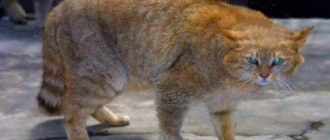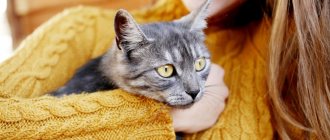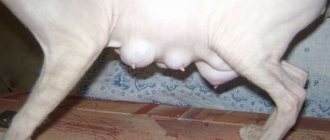How do they do it?
There are two main factors that allow a cat to right itself when it falls: hearing and flexibility. Like other animals, a cat's inner ear is part of their vestibular system, which helps with balance and influences spatial perception.
When a cat falls, the first thing it tries to do is straighten its head and neck. She then retracts her front legs and extends her hind legs to rotate the front half of her body. Once the cat is level and at maximum speed, it moves its limbs to a level position. So, when landing, all she has to do is pick up her paws and arch her spine.
Landing mechanism
Experiments with cats falling were carried out two centuries ago by French researchers. They changed the height, released the cat and analyzed its movements. For a long time it was believed that the tail was responsible for landing on four paws, because it was considered a kind of rudder. But later it turned out that even without a tail, the cat always lands on its paws.
© shutterstock
Regardless of the position in which the fall begins, in a very short time the cat's body turns around and aligns itself with the ground. In more detail it looks like this :
- The head turns first, so the cat sees and evaluates the place where it will land;
- then, along with the head, the whole body forms one line;
- she presses her front paws to her head;
- stretches its hind legs as far as possible.
Fast and precise rotation of the body also occurs due to excellent flexibility. Unlike a human, a cat's spine consists of 30 links, which provide its inherent elasticity and grace. The role of a shock absorber in cats is performed by developed, strong paw muscles and soft pads on them. They absorb the impact force during contact with the surface.
How do cats survive falling from great heights?
In addition to the ability to group, cats have a number of advantages that nature has endowed them with:
1. Skeleton. Flexible, lightweight bones coupled with their small size help cats remain more protected than other animals and people when falling from heights.
2. Resistance. Terminal velocity is the maximum speed an object reaches as it falls. It can be reduced by increasing drag, which is air resistance that can slow an object down. Cats have increased resistance due to the way they move their limbs when falling. Also resistance increases wool. This is why furry cats are more protected when falling from a height.
3. Paws. A cat's paws are strong and muscular. They help cats move unnoticed and also soften falls by acting as shock absorbers. The force of the blow is distributed between the four limbs and allows you to protect the body.
4. Tail. It can help stabilize the body when falling.
Short-tailed and tailless cats do not have this advantage, but this does not affect the righting reflex itself.
Do cats always land on 4 paws?
This ability has puzzled scientists since at least the early 19th century. Many studies and experiments have been carried out. At first it was believed that when animals are thrown, they are somehow pushed away from human hands and turn over.
However, the French scientist Etienne-Jules Marey discovered in 1894 that this was not the case. Using a chronophotographic camera, he was able to capture 60 frames per second of the cat landing. Then he watched the footage in slow motion and saw exactly how the fluffy stood up on 4 paws.
Later, his evidence helped other scientists delve deeper into the study of this phenomenon. And this reflex is called the “righting reflex.” When falling, cats can properly turn their body to land safely on the ground with their paws.
They determine exactly how to turn around using their vestibular apparatus (located inside the ears). Animals instantly orient themselves, determining where “down” is and where “up” is. Then they turn their head, and the body follows it.
A quick turnaround is ensured by the unique cat skeleton - they have no collarbones, and there are as many as 30 vertebrae in their flexible spine. Therefore, they can straighten their body in the desired direction very accurately and at high speed. In this case, during the “flight” the hind legs move slightly forward, under the body, and the front legs move closer to the muzzle to protect it from hitting the ground.
We also recommend reading:
Pet habits: what signals should you pay attention to? Top 7 Dogs That Are Great for Children Stubborn Personality: Dogs That Are Difficult to Train Ways to Correct Malocclusion in Puppies
Interesting! This reflex begins to develop in every feline at the age of 3 weeks. And by 7 weeks it is fully formed. But sometimes the reflex does not work, and the cat can actually break during a fall. The main factor that influences this is the height from which the animal “flies”.
Dangerous skill
Although a cat can survive a fall from a height, this does not mean that this always happens. Under the influence of gravity, the cat can still hit the ground hard, and the taller the building/tree, the stronger the impact. The animal may break bones, lose the ability to walk, or suffer life-threatening injuries.
In the wild, cats often spend time in trees, protecting themselves from predators and searching for prey. Domestic cats “compensate” for these instincts by climbing onto shelves, the backs of sofas and armchairs.
However, cats falling from a tree can get caught on bark or branches, but this is difficult to do on buildings or other man-made structures. This is why you should be very careful and not leave your pets alone in rooms with open windows. It is also recommended to install protective grilles and nets. It’s better to castrate cats so that they don’t have the desire to jump out of the window under the influence of hormones.
Photo:
Other Amazing Abilities
In addition to the ability to fall correctly, representatives of the cat family demonstrate other amazing abilities.
Ability to fit in any container
The cat easily places its body in small boxes, vases, dishes and other containers unsuitable for such use. Moreover, the unnatural position of the body does not cause any discomfort to the animal.
Treatment of hosts
Cats are true natural healers. They always subtly sense the condition of their owners and try to lie down on the place that hurts. Their positive impact on the psychological state of people leaves no doubt.
Premonition of Trouble
Numerous cases confirm the fact that cats are able to anticipate natural disasters, catastrophes that threaten misfortune to a person. Foresight is explained by the subtle intuition inherent in these animals and well-developed hearing. Thus, during the Second World War, people under fire often relied on the behavior of their pets.
The approaching bombers were indicated by a change in the cats' behavior: they began to worry and look for cover. In addition, a strong energetic connection is often established between the cat and the owner, as a result of which the animal senses the illness and approaching death of the person.
Terrain orientation
There are many cases where animals have found their home, despite vast distances. Lost or intentionally abandoned cats can return to their habitat, even when they are thousands of kilometers away. Numerous studies confirm such abilities of animals, but there is still no logical basis for this phenomenon.
Cats are amazing creatures that nature has endowed with different abilities. Scientists still have not found a scientific explanation for some animal talents.
Why can cats get injured when falling?
Sometimes cats don't have enough time to roll over in the right direction. The minimum height required for a cat to turn around is 30 cm. If the cat does not turn around, it can land on its back or side - places that are completely unsuitable for this. Thus, falls from a small height can be even more traumatic than from a height of several meters.
Another reason for accidents is that nature has endowed the cat with such a useful reflex for living in its natural habitat, but in a modern city this does not always save. A metropolis is too much of a challenge for a cat! Apartment buildings are much taller than trees, and you can’t catch on plastic and metal like you can on a branch.
In addition, cats that spend all their time in an apartment usually lead a sedentary lifestyle and are often even overweight, which sharply reduces their natural ability to survive. All other things being equal, where a wild, muscular, fit cat gets off with a slight fright, “Garfield” risks being crushed into a cake!
Therefore, let's not delude ourselves that a cat ALWAYS lands on its paws, but let's think about the safety of our furry friends. If you have a cat, then there should be nets on the windows, and the balcony should be glazed or always closed!
Photo of a black cat in flight Darren Sethe
Time-lapse photo of a cat falling sciencefocus.com, Oxford University press
Cats have many abilities that are beyond the control of humans: they see in the dark, their sense of smell is 14 times sharper, and their hearing is amazingly sensitive. In addition, the specific structure of the body explains why cats land on their feet. No other animal has a similar skill. This phenomenon is their unique gift.
A cat's flexibility starts with the spine!
In addition to muscles, flexible joints of the spine also play an important role for a successful flight. A cat, unlike a person, has more links in it (a cat has 30, a person has 24). This gives the spine elasticity and the same ability to gracefully bend the back, which a person is also trying to learn.
A well-developed vestibular apparatus allows the animal to orient itself in space during a fall, instinctively evaluate all chances and give the body the correct body position for landing.
Cats are small and light animals. Its mass in relation to body area is much less than that of a person. This also helps her group her body correctly.











